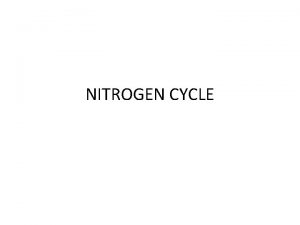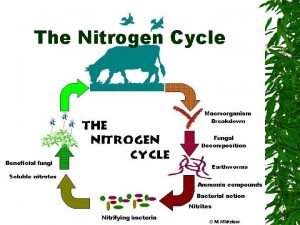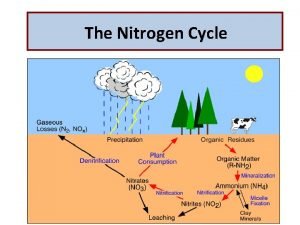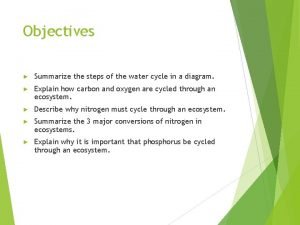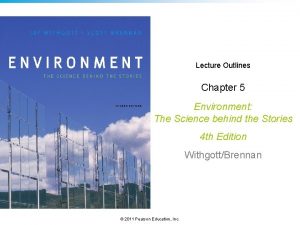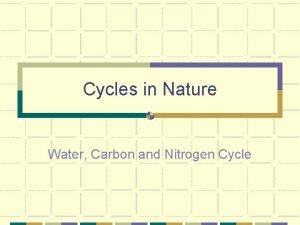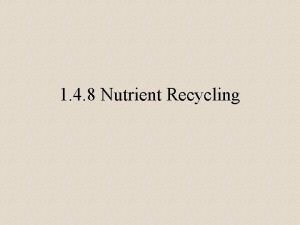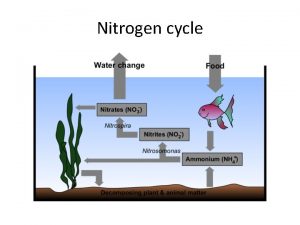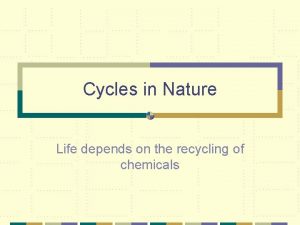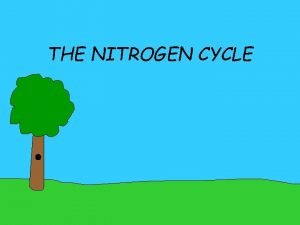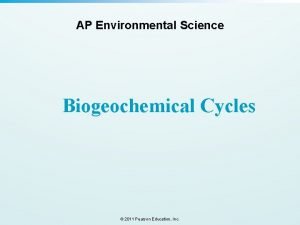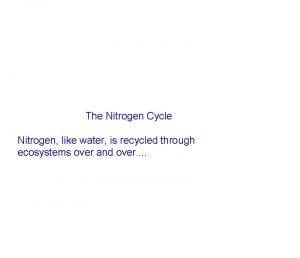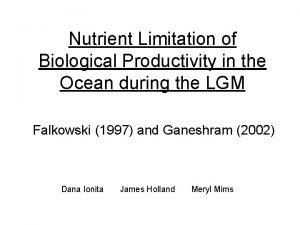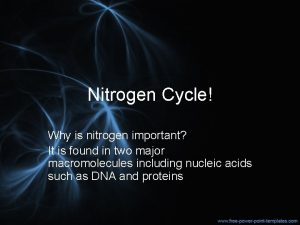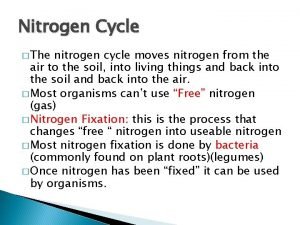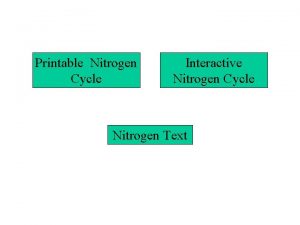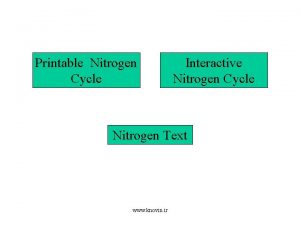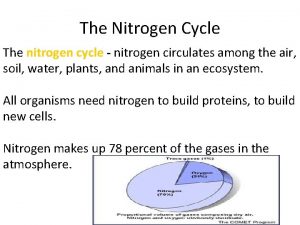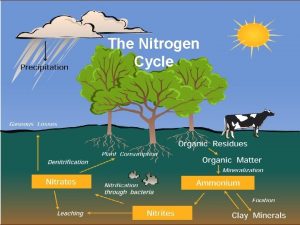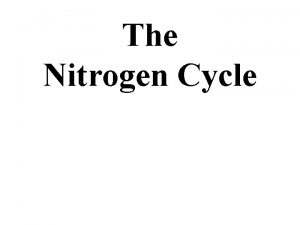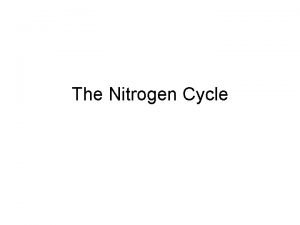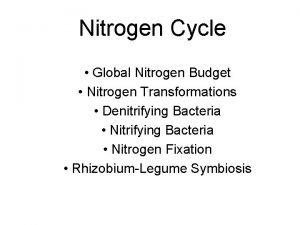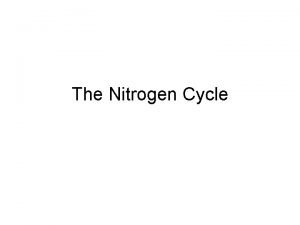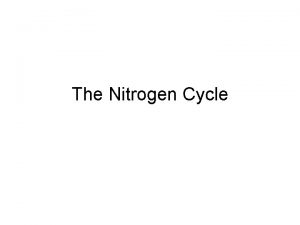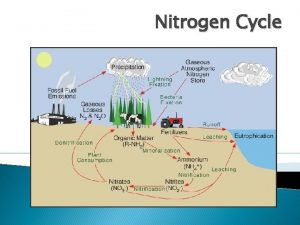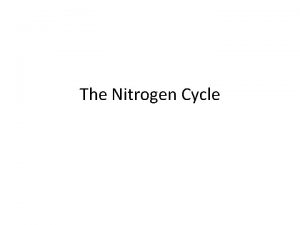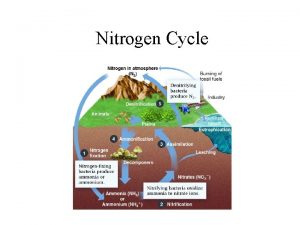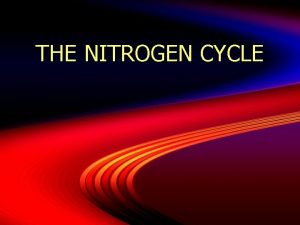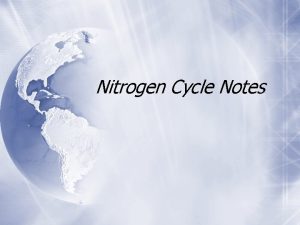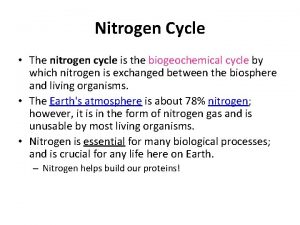NITROGEN CYCLE Where is nitrogen found in the




































- Slides: 36

NITROGEN CYCLE

Where is nitrogen found in the environment

The largest single source of nitrogen is in the atmosphere. Nitrogen makes up 78% of our air!

What happens to atmospheric nitrogen(N 2) in the nitrogen cycle? N N

Atmospheric nitrogen is converted to ammonia or nitrates. Atmospheric Nitrogen (N 2) N N Ammonia (NH 3)Nitrogen combines with Hydrogen to make Ammonia Nitrates (NO 3) Nitrogen combines with Oxygen to make Nitrates

Why does atmospheric nitrogen need to be converted? N N

• Nitrogen is an element used to build DNA, RNA, and proteins— the building blocks of life. • Although the majority of the air we breathe is nitrogen, most living organisms are unable to use nitrogen as it exists in the atmosphere!

How does atmospheric nitrogen get changed into a form that can be used by most living organisms? N N

By traveling through one of the four processes in the Nitrogen Cycle! (1) Nitrogen Fixation (4) Denitrification Nitrogen Cycle (2) Ammonification (3) Nitrification

What is “nitrogen fixation” and what does it mean to say nitrogen gets “fixed”? N N

“Nitrogen Fixation” is the process that causes the strong two-atom nitrogen molecules found in the atmosphere to break apart so they can combine with other atoms. Oxygen N N Hydrogen Nitrogen gets “fixed” when it is combined with oxygen or hydrogen.

There are three ways that nitrogen gets “fixed (a) Atmospheric Fixation (b) Industrial Fixation (c) Biological Fixation

Lightning “fixes” Nitrogen! N N O O Atmospheric Fixation (Only 5 to 8% of the Fixation Process The enormous energy of lightning breaks nitrogen molecules apart. Nitrogen atoms combine with oxygen forming nitrogen oxides (N 2 O). Nitrogen oxides dissolve in rain, forming nitrates. Nitrates (NO 3) are carried to the ground with the rain. Nitrogen combines with Oxygen (N 2 O) (NO 3) Nitrogen oxides forms Nitrogen oxides dissolve in rain and change to nitrates Plants use nitrates to grow!

Industrial Fixation Under great pressure, at a temperature of 600 degrees Celcius, and N with the use of a catalyst, atmospheric nitrogen (N 2) and NH 3 hydrogen are combined to form ammonia (NH 3). Ammonia can be used as a fertilizer. H Industrial Plant combines nitrogen and hydrogen Ammonia is formed Ammonia is used a fertilizer in soil

Biological Fixation (where MOST nitrogen fixing is completed) There are two types of “Nitrogen Fixing Bacteria” Free Living Bacteria (“fixes” 30% of N 2) Symbiotic Relationship Bacteria (“fixes” 70% of N 2)

Free Living Bacteria Highly specialized bacteria live in the soil and have the ability to combine atmospheric nitrogen with hydrogen to make ammonia (NH 3). N N H H NH 3

Symbiotic Relationship Bacteria live in the roots of legume family plants and provide the plants with ammonia (NH 3) in exchange for the plant’s carbon and a protected Legume plants home. Roots with nodules where bacteria live

Most atmospheric nitrogen (N 2) is “fixed” and changed to ammonia (NH 3). Ammonia is highly toxic to many organisms. Very few plants can use ammonia (NH 3)…

(1) Nitrogen Fixation (2) Ammonification …but, fortunately the second process Ammonification can help! What is ammonification?

Ammonification: Bacteria decomposers break down amino acids from dead animals and wastes into nitrogen ammonium.

Why is ammonification necessary?

Because plants cannot use the organic forms of nitrogen that are in the soil as a result of: (1) wastes (manure and sewage) (2) compost and decomposing roots and leaves

How does ammonification occur? Microorganisms convert the organic nitrogen to ammonium. The ammonium is either taken up by the plants (only in a few types of plants) or is absorbed into the soil particles. Ammonium (NH 4) in the soil is stored up to later be changed into inorganic nitrogen, the kind of nitrogen that most plants can use.

Bacteria converts organic nitrogen to ammonium (NH 4) Ammonium (NH 4) is used by some plants Ammonium (NH 4) is stored in soil.

What happens to ammonium (NH 4) stored in the soil?

It travels through the third process of the nitrogen cycle called Nitrification! (1) Nitrogen Fixation (3) Nitrification (2) Ammonification

Nitrifying bacteria in the ground combine ammonia with oxygen to form nitrites. Then another group of nitrifying bacteria convert nitrites to nitrates which green plants can absorb and use! Nitrifying bacteria in soil combine ammonia with oxygen Ammonia changes to nitrites Nitrifying bacteria in soil convert nitrites to nitrates Ammonia NH 3 Nitrites Nitrates NO 2 NO 3 Plants absorb nitrates and grow!

Nitrification is a Two Step Process 1. First Step: Ammonium Oxidation The microorganisms involved are called the ammonia oxidizers. Ammonia-Oxidizing Bacteria: These organisms are chemoautotrophs, growing with ammonia as the energy and CO 2 as the main carbon source. Species are distributed in a great variety of soils, oceans, brackish environments, rivers, lakes, and sewage disposal systems.

2. Second step: Nitrite Oxidation (denitrification). Nitrite-oxidizing bacteria are found in aerobic, but occasionally also in anaerobic, environments where organic matter is mineralized. They are found in soils, fresh water, brackish water, seawater, mud layers, sewage disposal systems, and inside stones of historical buildings and rocks, also found inside corroded bricks and on concrete surfaces such as in cooling towers and highway tunnels.

How does nitrogen reenter the atmosphere in the nitrogen cycle? Through the fourth process called denitrification! (4) Denitrification (3)Nitrification (1) Nitrogen fixation (2) Ammonification

What does denitrification do? Denitrification converts nitrates (NO 3) in the soil to atmospheric nitrogen (N 2) replenishing the atmosphere. Nitrogen in atmosphere (N 2) Nitrates (NO 3) in Soil

Denitrifying bacteria live deep in soil and in aquatic sediments where conditions make it difficult for them to get oxygen. The denitrifying bacteria use nitrates as an alternative to oxygen, leaving free nitrogen gas as a byproduct. They close the nitrogen cycle! Nitrogen in atmosphere closes the nitrogen cycle (N 2) (NO 3) Denitrifying bacteria live deep in soil and use nitrates as an alternative to oxygen making a byproduct of nitrogen gas.

Other ways that nitrogen returns to the atmosphere… Emissions from industrial combustion and gasoline engines create nitrous oxides gas (N 2 O). Volcano eruptions emit nitrous oxides gas (N 2 O).

(a) (b) N 2 O (4) Denitrification (1) Nitrogen Fixation (c) Nitrogen Cycle (3) Nitrification (2) Ammonification NH 3 NO 3 Ammonia is converted to nitrites and nitrates. Nitrates in Soil Organic nitrogen is converted to ammonium.

(a) (b) N 2 O (4) _______ (1) _______ (c) Nitrogen Cycle (3) ______ (2) _______ NH 3 NO 3 Ammonia is converted to nitrites and nitrates. Nitrates in Soil Organic nitrogen is converted to ammonium.

 Nitrogen is found in
Nitrogen is found in Nitrogen cycle vocabulary
Nitrogen cycle vocabulary Nitrogen cycle examples
Nitrogen cycle examples Nitrogen cycle interactive
Nitrogen cycle interactive Summarize the steps of the water cycle.
Summarize the steps of the water cycle. Carbon cycle pearson education
Carbon cycle pearson education Nitrogen cycle diagram leaving cert
Nitrogen cycle diagram leaving cert Nitrogen cycle comic strip
Nitrogen cycle comic strip Nutrients recycling
Nutrients recycling Nitrogen cycyle
Nitrogen cycyle Importance of nitrogen cycle
Importance of nitrogen cycle Conclusion of nitrogen cycle
Conclusion of nitrogen cycle Carbon cycle comic strips
Carbon cycle comic strips Nitrogen cycle cow
Nitrogen cycle cow Alliteration for cycle
Alliteration for cycle Nitrogen cycle
Nitrogen cycle Pearson
Pearson Nitrogen for plants
Nitrogen for plants Tank cycling
Tank cycling Nitrogen cycle diagram
Nitrogen cycle diagram Poem nettles
Poem nettles Nitrification in the nitrogen cycle
Nitrification in the nitrogen cycle Nitrogen cycle
Nitrogen cycle Nitrogen cycle diagram simple
Nitrogen cycle diagram simple Hát kết hợp bộ gõ cơ thể
Hát kết hợp bộ gõ cơ thể Slidetodoc
Slidetodoc Bổ thể
Bổ thể Tỉ lệ cơ thể trẻ em
Tỉ lệ cơ thể trẻ em Voi kéo gỗ như thế nào
Voi kéo gỗ như thế nào Glasgow thang điểm
Glasgow thang điểm Chúa yêu trần thế
Chúa yêu trần thế Các môn thể thao bắt đầu bằng tiếng bóng
Các môn thể thao bắt đầu bằng tiếng bóng Thế nào là hệ số cao nhất
Thế nào là hệ số cao nhất Các châu lục và đại dương trên thế giới
Các châu lục và đại dương trên thế giới Công của trọng lực
Công của trọng lực Trời xanh đây là của chúng ta thể thơ
Trời xanh đây là của chúng ta thể thơ Mật thư anh em như thể tay chân
Mật thư anh em như thể tay chân
